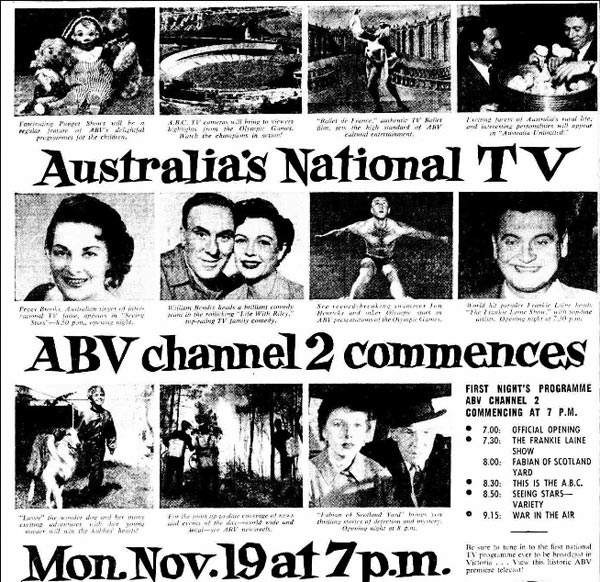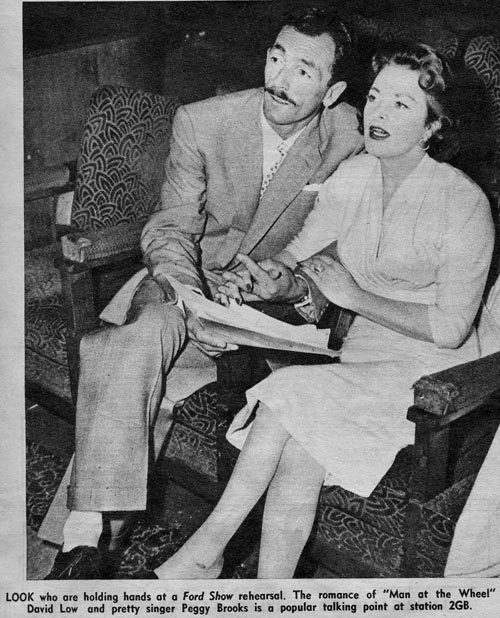© Valda Low
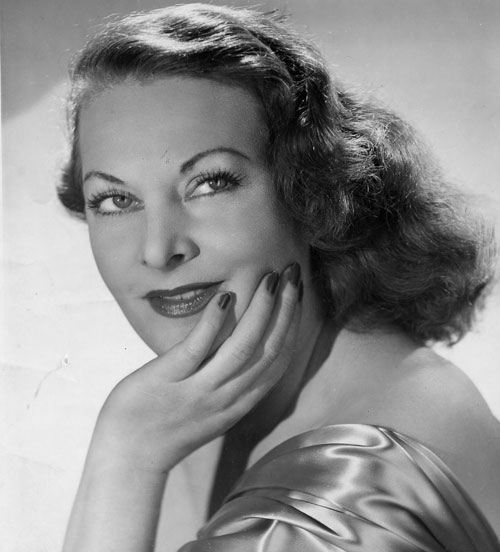 Peggy Brooks was born Jean Linda Switzer in 1912 Footscray, Vic, to Henry Andrew Switzer and Emily Jean McCubbin, (known as Harry and Emma). She studied toe, ballet, and tap dancing with Jennie Brenan in Melbourne, Her first known foray into the world of entertainment was as a dancer at the age of fifteen when she did her first shows at the Saturday night “pops” at the local theatres.
Peggy Brooks was born Jean Linda Switzer in 1912 Footscray, Vic, to Henry Andrew Switzer and Emily Jean McCubbin, (known as Harry and Emma). She studied toe, ballet, and tap dancing with Jennie Brenan in Melbourne, Her first known foray into the world of entertainment was as a dancer at the age of fifteen when she did her first shows at the Saturday night “pops” at the local theatres.
It was also as a dancer that she joined the Merry Review Company to tour through Queensland and it was with this company that she began to perform as a novelty whistler. During a show, Paul Sarony, a lightning-sketch artist, heard her whistling in her dressing-room. He warned her that it was “bad luck” to do this, but said that if she must whistle, he would like her to do so during his act. So Peggy joined Sarony’s act, and whistled off-stage during their stay with the “Merry Revue Co.” and later with Hoyt’s Circuit. (( Illustration of Smoky Dawson from The Mail (8 Oct 1949 ))
David Low introduces Peggy singing “When You’re Smiling”, on The Ford Show

After singing soubrette numbers on variety shows and at ABC Community Singing sessions she was given her first radio performance as guest star with Jim Davidson and the ABC Dance Band in August 1935
She then began singing and crooning regularly for radio and for the Tivoli Circuit.
In 1936 she toured Queensland and NSW with George Sorlie’s Musical Review and was billed as Jean Switzer, the whistlingsoubrette – and sometimes Jeanne Switzer – the girl who can sing, dance, and whistle. The following year she was billed in August at the Luxor Theatre in Perth, WA as JeanSwitzer, soubrette and dancer from the Capitol Theatre, Melbourne.
By 1937 Peggy changed her name and had become a lead singer on the Smoky Dawson Show which attracted sponsorship from Pepsodent on radio 3XY in Melbourne and became the first live country show on Australian radio. It was rebroadcast in NSW on 2CH as “Hill-billy Artists”. The group was called the “South Sea Islanders” and included Peggy and Alec McKellan who was later known as Al Royal. The group introduced some of the first Hawaiian music into Australia. (( Adelaide Mail, 8 October 1949 ))
The same year she performed on the Shell Show of 1937 which was broadcast to five States from the Comedy Theatre. It was a variety show sponsored by the Shell Co of Australia.
Peggy’s popularity as a singer continued to grow and with the coming of WW2 she found herself more in demand.
HAPPY LANDINGS (1940)
To augment the funds of Air Force House, members of the, Department of Civil Aviation presented an entertaining revue, Happy Landings, at Central Hall last evening. The varied programme included orchestral Items, songs, ballets, sketches and comedy numbers. Artists included Peggy Brooks and Smoky Dawson.
Throughout 1940 and 1941 Peggy was also singing on Paul Jacklin’s MERRY-GO-ROUND as the featured vocalist with the the ABC dance orchestra conducted by Denis Collinson.
Peggy Brooks is a star artist in the light entertainment features ‘Merry-Go-Round’ and ‘Strike Up the Band’emanating from Melbourne. She is the popular vocalist whom Paul Jacklin always introduces to his big all Australia audience as “The auburn haired sweetheart of song”.
Letters arrived from all over Australia when Merry-Go-Round held a nation-wide poll to determine what have been the radio program’s most popular features … ‘The Auburn-haired Sweetheart of Song,’ had many staunch admirers, as shown by the following extract from a remote station in New South Wales:
8pm to 9pm – items by Peggy Brooks, with five minutes between songs:
Also a bottle of the best champagne for the artist — more champagne If she needs it. We up here consider Peggy in the light of the Star of Stars. If you cannot give us a little more of her artistic temperament, we have decided to sell the wireless set and buy a phonograph.’
When band leader Denis Collinson went to commercial radio in the early 1940s, Peggy moved with him.
PATRIOTIC WORK
Peggy continued to grow her singing career and was kept very busy with radio and theatrical work. She also spent a good deal of her time performing to raise funds for the War effort, singing at camps and hospitals and at patriotic gatherings. She found that the “men of the fighting forces” like patriotic songs with a swing, but they always enjoyed sentimental songs “which seemed to appeal to those about to leave their loved ones or when they are away from their homes”. Her favourite patriotic songs with a swing were Tipperary and Tiggerty Boo.
“Whenever I go to a camp or hospital I have to sing those two songs,” she said. “There is a great demand from the boys also for The Wizard of Oz, particularly when they know that the A.I.F. is in action.”
PEGGY BROOKS POPULAR IN LAUNCESTON (1941)
Vivacious, auburn-haired Peggy Brooks, radio and theatrical star, who does much patriotic work, will return to Melbourne today deeply impressed by the wonderful reception accorded her at the war rally in the Albert Hall on Tuesday night. Miss Brooks came to Tasmania at the invitation of the president of the Launceston sub–branch of the Returned Soldiers’ League (Mr. A. . McKenzie) to appear at the war rally.
“When the telephone call came from Launceston I thought there must be a mistake,” said Miss Brooks yesterday. “However, when I was told of the war rally I was happy to accept the invitation, and it has been a memorable experience.“
When Miss Brooks left the Brisbane Hotel to go to the Albert Hall on Tuesday night her car was surrounded by an enthusiastic crowd, and a police escort had to extricate it.
“It was quite a thrill,” said Miss Brooks. “and I want to thank the people of Launceston for the warm-hearted reception they gave me at the Albert Hall. It was the most appreciative audience I have ever had, and I am happy to know that they liked me.” (( The Examiner – 29 May 1941 ))
Peggy frequently received gifts from soldiers who had heard her sing and had sent her presents from ports of call abroad.
PEGGY GETS MARRIED … TWICE
In 1941 Peggy was married to George Joseph Dudley in her hometown of Melbourne. Perhaps because she had been an amateur cycling champion a few years before, he bought
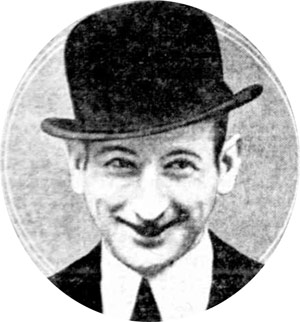
her a bicycle and they would go cycling together, perhaps around Albert Park where Peggy also enjoyed sailing on the lake. She also used the bike to do her shopping.
Unfortunately her marriage to George was short lived and in June 1945 she was married again, this time to Frenchman Andre Vlllenave. She had an eternity ring made for their 1st anniversary and they holidayed for a week in Coolangatta at the Hotel by the same name.
On their return Peggy, now being billed as a leading radio singer, appeared at a gala show at the Leichhardt Stadium. Proceeds were in aid of the Youth Campaign appeal. Comedian Roy Rene(“Mo”) refereed a boxing bout, and champion wrestlers appeared. (( The Sun – 22 June 1946 ))
FRANCE AND ENGLAND HERE WE COME
Peggy had become well known for being a vocalist in Soft Lights and Sweet Music for the ABC and later was vocalist in the Shell Show for two years.
In mid December 1946, Peggy made one of her final radio broadcasts in Australia before leaving with Andre for France then England. (( singing with the Clive Amadio Quintet from 5CL at 7pm, Dec 14 )) They had intended to leave the April before but Peggy had been a featured vocalist for quite a long time with “Calling the Stars” and other top-line shows. (( Radio Roundabout – 14 Dec 1946 ))
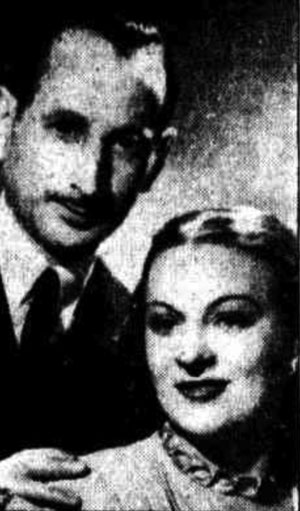
Peggy’s last appearance on air was on January 31, 1947 on radio 2UE’s Colgate Cavalcade. They sailed 4 days later on the Dominion Monarch for France on February 4. She took with her many of the recordings she had made and when the BBC heard them they offered her the guest spot in Monday Night at Eight and as guest artist on the famous radio session “Navy Mixture“. (( The Life of Melbourne – 5 April 1947 ))
In all Peggy made four trips to France during their overseas stay. In Paris, Andre studied the “delicate art of serving food and wines”.
They visited Andre’s parents whom he hadn’t seen for 23 years. (( “Radio Singer Making Name” Truth – 5 Oct 1947 )) The family home was in St Vincent’s, a village near Biarritz, where no-one could speak English and where her sister-in-law expected her to be black because she was Australian. However they served the most beautiful food.
Peggy had always been a keen cook but since her marriage to a professional chef and their visits to France she was interested in the art more than ever.
Peggy is blessed among women for not only does her husband do most of the cooking, and all of it when they entertain, he does the marketing as well and buys the best at the keenest prices. “With the French, marketing is another art,” Peggy said. (( The Listener In – April 1949 ))
A crowded two years abroad saw Peggy singing over the radio and in music halls in England, Scotland and France. Following her guest spot in Monday Night at Eight the BBC offered to feature her in own show, Serenade. “She was told to pick her own night, name the kind of show she wanted to do, and the kind of music and number of musicians she wished to accompany her.” (( Listener In – April 1949 )) This was a series and it was followed by Bandbox.
She also appeared on TV for the first time. Variety was the first ever programme broadcast when regular British television broadcasts commenced. Peggy appeared on 1 episode in 1948.
She described the difficulty of appearing before television cameras after ordinary stage and radio shows. “I would stand before a mirror to study my facial movements before I felt satisfied to go before the cameras,” she said. (( West Australian – 16 May 1949 ))
While still performing on Bandbox for the BBC, Peggy teamed up in a singing act with Val Merrall, a nephew of Bud Flanagan (of Flanagan and Allen). The pair did some variety work in England where they were signed for a series of appearances on a big Sunday night variety show for the BBC. They also recorded for Decca.
Starting on May17 1947 they opened as leads in a stage show in Ayr’s Gaiety Theatre in Scotland for a twice daily 26 week season. This found them dashing down to London each weekend to appear in the BBC’s Variety Bandbox session.
This was followed by a three week vacation in Paris during which she had a two week engagement the commercial station Radiodifusion Francaise. She described this as a real picnic. “The French run their radio in a very haphazard way. Everyone has a great time.”
A highlight was being chosen by the French Underground Movement to represent Australia at a gala entertainment at the Palais de Chaillot in Paris—scene of U.N.O. Conferences. (( Argus 22 Feb 1949 )) “Singing to an audience of 15,000 at a concert in Paris was one of the highlights of my two years overseas,” she said.
HOME AGAIN .. BUT NOT FOR LONG
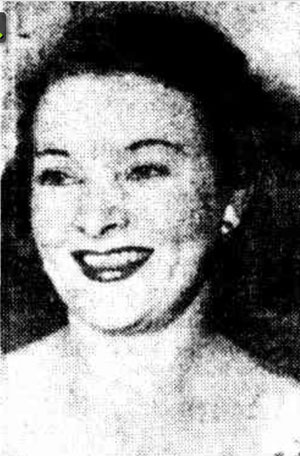 When Peggy and Andre decided to return to Australia, they sailed for home on the Orion from London on January 29, 1949.
When Peggy and Andre decided to return to Australia, they sailed for home on the Orion from London on January 29, 1949.
Platform soles two and a half inches high are worn by red-haired singer Peggy Brooks who returned in the Orion today to star in a series of ABC shows. Miss Brooks, who is under five feet tall, wore them for all her stage and television appearances in the two years she was abroad. (( News – 25 February 1949 ))
On their return Andre commenced work as assistant manager at Romano’s – where he had worked as a waiter in the past. Hailed as a rival to Vera Lynn after her recent success in BBC programmes, Peggy signed a three months (13 week) contract with the ABC to do a Commonwealth tour which included a series of concerts. These were broadcast weekly for 4 weeks each in Sydney and Melbourne and 2 weeks in Adelaide and Perth (finishing in Western Australia in May).
On June 12 she appeared as a soloist with the Clive Amadio Quintet in a broadcast from 3AR and sang La Vie En Rose and My Heart Sings.
OFF OVERSEAS AGAIN
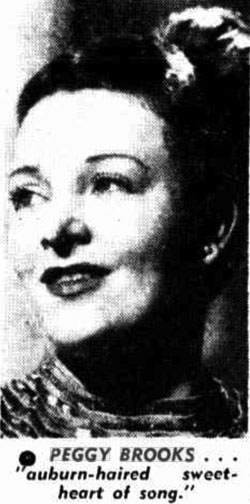 Not long after her return Peggy was making plans to head to America. She was hoping to break into television there, besides radio. During her two years in England, one of her regular BBC programs — Serenade — had a big fan following in America. She was “banking on this to help her crack the tough US entertainment field”. (( The Sun – 30 Aug 1949 ))
Not long after her return Peggy was making plans to head to America. She was hoping to break into television there, besides radio. During her two years in England, one of her regular BBC programs — Serenade — had a big fan following in America. She was “banking on this to help her crack the tough US entertainment field”. (( The Sun – 30 Aug 1949 ))
Her last live broadcasts in Australia, before leaving for America included Calling the Stars (2UE), and the ABC Hit Parade (2FC), both in August. She also did several Cashmere Bouquet programs, which were recorded ahead.
On September 9 1949, she sailed on the Ventura from Adelaide without Andre who was to remain in Australia.
Why does songbird Peggy Brooks have to desert us again? This time she’s off to USA to do some television encores, and doubtless acquire another wardrobe of dazzling gabardine suits. Meanwhile, husband Andre (an artist in his own right, if you’ve ever sampled his international cookery magic) will remain at Romano’s and smile a sad, lonely smile.
In her first year she worked at establishing herself and by 1951 she was in Canada co-starring in a show with Lou Snider, a Canadian organist/pianist/composer who also served as music director, in the summer of 1951, for ‘Time for a Song‘ starring Peggy and Howard Manning. She also starred in CBC television.
Thousands of Australian radio listeners will be interested to hear of the success of Peggy Brooks (Sweetheart of Song) in Canada where she is taking a lead part in The Howard Manning Show — recently she co-starred with Eddie Cantor. Critic Tom Briggs wrote of her, “Miss Brooks, recent- import from Australia, can be heard almost any time on some spot on a radio dial. She’s always pleasant to listen to. (( 2 May 1951 ))
On 18 Sept 1951, back in Australia, husband Andre was in the Bankruptsy Court owing to Nock and Kirby.
The Sun newspaper noted that Peggy was planning to return to Australia around this time. It suggested she was booked to appear at the Club Caronia, a new Sydney nightspot (formerly Reg’s) opening under the management of radio’s Dick Hyde, who has already signed bandleader Reg Redgrave and, vocalist Olive Lester (of the ‘Lester Sisters) to look after the musical side. (( The Sun – 6 March 1951 )) (She returned home for a working holiday twice while in Canada .. now, and again in 1956.)
By contrast, six months later Peggy was listed among the top radio and TV artists of Canada for 1952. In fact, for seven years running she was voted the number one vocalist in Canada. One radio columnist ranked her among the best artists on the Canadian air, and gave her the top vote for female vocalists among Canada’s favourite radio and TV personalities. Another columnist devoted considerable space to a eulogy of “the Australian thrush now being heard on 30 Canadian stations.” (( Sun-13 March 1953 ))
By August 1954 Andre Villenave had finally overcome his bankrupt state and had moved on from being the head waiter at Chequers Nightclub to opening his own new nightclub, Andre’s in Castlereagh Street Sydney.
We hear it’ll be quite a place — and it should be. An army of workmen has been re-modelling It for two months. We also hear that the total pay-out before the first night will be close to £40,600. Which proves two things:
You’ve got to have a lot of money to start a nightclub.
Head waiters must make a lot of money. [/efn_note]Daily Telegraph – 13 August, 1954 [/efn_note]
In a letter home to ABC Variety director Harry Pringle, Peggy mentioned that she was doing regular New York radio and TV shows. She was also doing a daily “disc jockey” session in Canada and writing all her own weekly Canadian Colgate radio shows which became The Peggy Brooks Show.
“The Peggy Brooks Show became mine through an ‘ill wind’, she explained. “Personal reasons caused the previous compare to leave the show and I was asked to ad lib until another one was found. When the sponsors knew I could do it, I was asked to continue.”
Although petite, auburn-haired Peggy has acquired a pretty solid Canadian accent over the years, she is still OUR MISS BROOKS at heart, with a very soft spot for her homeland. Last January she managed to induce the Toronto station she works for to feature an “Australian Day Show” (they’d never heard of it, sad. to relate) and took the opportunity to sing a program of Aussie songs to her listeners there. Needless to say, this brought a flock of mail from rather homesick Australians, now living in Canada, and put Peggy in touch again with several friends in the sister Dominion. PEGGY BROOKS’ main chore in radio abroad is her program called “Two for a Quarter”, which she and partner CY MACK present for 15 minutes daily at 10.15a.m.
The local girl has now launched out from singing, plays discs, gives cooking hints and even household ideas in this regular morning spot. (( Argus – 10 November 1956 ))
BACK HOME AND ALMOST SINGLE AGAIN
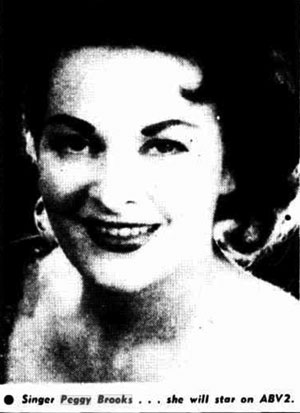 In 1956 with reports filtering through from Toronto regularly, it was quite clear that Peggy was on the top rung there, with a show of her own and frequent appearances in nightclubs and on Canadian television as a compere and vocalist. Despite this, Peggy returned home to Australia for a holiday. It was her second since leaving home, and she planned on returning to Toronto early the following year.
In 1956 with reports filtering through from Toronto regularly, it was quite clear that Peggy was on the top rung there, with a show of her own and frequent appearances in nightclubs and on Canadian television as a compere and vocalist. Despite this, Peggy returned home to Australia for a holiday. It was her second since leaving home, and she planned on returning to Toronto early the following year.
By now Andre and Peggy were in the throes of a divorce. Perhaps this was a reason for her return.
However, Peggy’s career continued on a high and she had regular work. Sydney tv station TCN had a new live show, at 9.30 on Tuesday nights called RENDEZVOUS at Romano’s. It was compered by Harp Maguire. It came direct from the nightclub and showed the floor show and the regular Herbie Marks and his trio with Peggy Brooks. (( Australian Women’s Weekly – 10 April 1957 ))
In October, when our Miss Brooks sang “Love is a Many Splendored Thing” in JIM GUSSEY’S Band Waggonon 3AR, all the artistry, plus a wealth of experience, was well in evidence. Peggy Brooks is singing beautifully, and once again proved that there is no trick or gimmick that can match a really good voice. (Are you listening, ELVIS?) We can expect to hear Peggy in Melbourne very shortly. (( Argus – 13 October 1956 ))
1956 was the year Australia hosted the Olympic Games in Melbourne. Peggy became known in Canada as “The Voice of the Australian Olympiad” as she interviewed visitors to the Games for the Canadian Broadcasting Commission. She found many suitable subjects during a tour of the Olympic Village.
“As soon as I hear of possible personalities for the radio program, I arrange interviews for taping,” said Peggy who by now had been living in Canada for almost eight years. “It means much rushing about but that doesn’t worry me – I’m used to high pressured living.” (( The Sun – 4 December 1956 ))
November saw the opening night of Melbourne’s second TV station, the ABC‘s ABV2. Peggy was said to be one of the principal attractions, both as compare and star vocalist. As part of the opening ceremony she sang assisted by Arthur Young at the piano. Later she hosted a 25 minute variety show called Seeing Stars. It featured her singing, Kenric Hudson‘s comedy sketch, ‘Types of Televiewers’ as well as visiting US pianist Joe “Fingers” Carr.
Peggy and Andre’s marriage lasted 10 years it ended the same month as the TV station opened. They had started divorce proceedings in 1955, finally ending their marriage in November, 1957. (( Divorce papers for Andre Villenave – Peggy Villenave: date range from 11 Mar 1955 to 27 Nov 1957 (State Archives NSW) ))
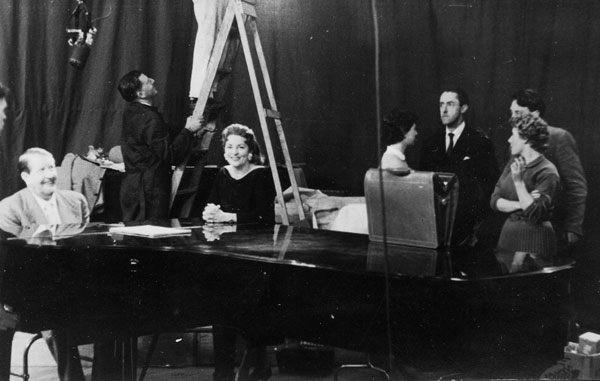
A NEW ROMANCE AND MARRIED AGAIN
While waiting for her divorce from Andre to be finalised, Peggy was photographed holding hands with David Low during a Ford Show rehearsal. (( He was the show’s compere and Jim’s much older half-brother (so my brother-in-law) )) Their new romance was a talking point at radio station 2GB.
The TCN9 television series Bandwaggon started on 24 January 1958. It was a live variety show featuring Bob Gibson’s band and included Jack Allen, Peggy Brooks, Ray Dickson, Ted Hamilton and Dawn Lake.
David and Peggy were married in North Sydney in 1959 by the Rev Roger Bush. (( Roger Bush was a Methodist minister. He hosted an early 3 hour talkback radio program on radio 2CH called Connections. Bush wrote a column for the Sydney Sun newspaper for 12 years as well as a number of books )) David had been married twice before as had Peggy. They were to remain together until their deaths in Melbourne after 2000.
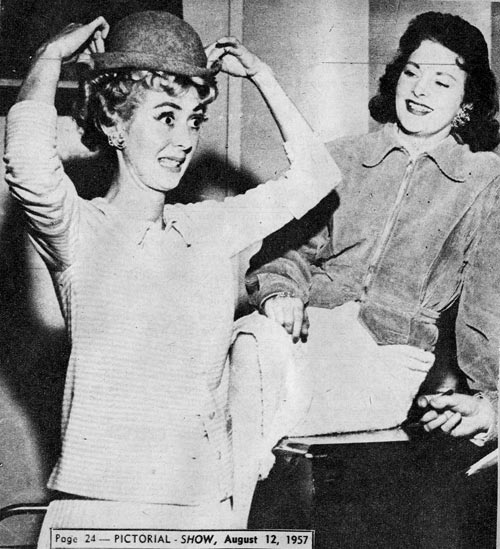
FOOTNOTES:

